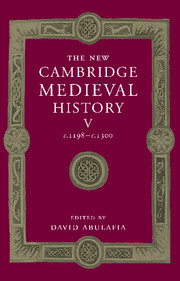Book contents
- Frontmatter
- Introduction
- Part I Common Themes
- Part II The Church in the Thirteenth Century
- Part III The Western Kingdoms
- Part IV Italy
- Part V The Mediterranean Frontiers
- 17 Byzantium after the Fourth Crusade
- (a) The Latin empire of Constantinople and the Frankish states in Greece
- (b) Byzantium in exile
- 18 The crusades
- 19 Islam and the Mediterranean
- 20 The rise of Aragon-Catalonia
- 21 Castile, Portugal and Navarre
- Part VI The Northern and Eastern Frontiers
- Appendix Genealogical tables
- Primary sources and secondary works arranged by chapter
- Index
- Plate section
- Map 1 Europe in the thirteenth century
- Map 3 France, c. 1260
- Map 5 Germany and the western empire
- Map 6 Genoa, Venice and the Mediterranean
- Map 8 The Latin empire of Constantinople and its neighbours
- Map 10 Aragon and Anjouin the Mediterranean">
- References
(b) - Byzantium in exile
from 17 - Byzantium after the Fourth Crusade
Published online by Cambridge University Press: 28 March 2008
- Frontmatter
- Introduction
- Part I Common Themes
- Part II The Church in the Thirteenth Century
- Part III The Western Kingdoms
- Part IV Italy
- Part V The Mediterranean Frontiers
- 17 Byzantium after the Fourth Crusade
- (a) The Latin empire of Constantinople and the Frankish states in Greece
- (b) Byzantium in exile
- 18 The crusades
- 19 Islam and the Mediterranean
- 20 The rise of Aragon-Catalonia
- 21 Castile, Portugal and Navarre
- Part VI The Northern and Eastern Frontiers
- Appendix Genealogical tables
- Primary sources and secondary works arranged by chapter
- Index
- Plate section
- Map 1 Europe in the thirteenth century
- Map 3 France, c. 1260
- Map 5 Germany and the western empire
- Map 6 Genoa, Venice and the Mediterranean
- Map 8 The Latin empire of Constantinople and its neighbours
- Map 10 Aragon and Anjouin the Mediterranean">
- References
Summary
IT was almost unthinkable that the Queen of Cities should fall. It was in the words of Byzantine contemporaries a ‘cosmic cataclysm’. The Byzantine ruling class was disorientated and uprooted. The Constantinopolitan elite sought refuge where they could. Among the common people there was at first a sense of jubilation at their discomfiture: the proud had been humbled. Such was the demoralisation that at all levels of society submission to the conquering crusaders seemed a natural solution. Many leading Byzantines threw in their lot with the Latins. The logothete of the drome Demetrios Tornikes continued to serve them in this capacity. He was the head of one of the great bureaucratic families, who had dominated Constantinople before 1204. In the provinces leading families made deals with the conquerors. Theodore Branas governed the city of Adrianople – the key to Thrace – on behalf of the Venetians. Michael Doukas – a member of the Byzantine imperial house – took service with Boniface of Montferrat, now ruler of Thessalonika. The cooperation of the local archontes smoothed Geoffrey de Villehardouin’s conquest of the Peloponnese.
The crusaders elected a Latin emperor and created a Latin patriarch of Constantinople. There seemed every possibility that Byzantium would be refashioned in a Latin image. For exactly a year the Latins carried all before them. Then in April 1205 their success came abruptly to an end. They had alienated and underestimated the Bulgarians, who crushed them at the battle of Adrianople. Many of the crusade leaders were killed. The Latin Emperor Baldwin of Flanders was led away into captivity, never again to be seen alive.
Keywords
- Type
- Chapter
- Information
- The New Cambridge Medieval History , pp. 543 - 568Publisher: Cambridge University PressPrint publication year: 1999
References
- 1
- Cited by

